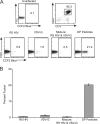R5 HIV env and vesicular stomatitis virus G protein cooperate to mediate fusion to naive CD4+ T Cells
- PMID: 20980513
- PMCID: PMC3014180
- DOI: 10.1128/JVI.01851-10
R5 HIV env and vesicular stomatitis virus G protein cooperate to mediate fusion to naive CD4+ T Cells
Abstract
Naïve CD4(4) T cells are resistant to both HIV R5 env and vesicular stomatitis virus G protein (VSV-G)-mediated fusion. However, viral particles carrying both HIV R5 env and VSV-G infect naïve cells by an unexplained mechanism. We show that VSV-G-pseudotyped virus cannot fuse to unstimulated cells because the viral particles cannot be endocytosed. However, virions carrying both HIV R5 env and VSV-G can fuse because CD4 binding allows viral uptake. Our findings reveal a unique mechanism by which R5 HIV env and VSV-G cooperate to allow entry to naïve CD4(+) T cells, providing a tool to target naïve CD4(+) T cells with R5 HIV to study HIV coreceptor signaling and latency.
Figures




References
-
- Agosto, L. M., J. J. Yu, M. K. Liszewski, C. Baytop, N. Korokhov, L. M. Humeau, and U. O'Doherty. 2009. The CXCR4-tropic human immunodeficiency virus envelope promotes more-efficient gene delivery to resting CD4+ T cells than the vesicular stomatitis virus glycoprotein G envelope. J. Virol. 83:8153-8162. - PMC - PubMed
-
- Amara, A., A. Vidy, G. Boulla, K. Mollier, J. Garcia-Perez, J. Alcami, C. Blanpain, M. Parmentier, J. L. Virelizier, P. Charneau, and F. Arenzana-Seisdedos. 2003. G protein-dependent CCR5 signaling is not required for efficient infection of primary T lymphocytes and macrophages by R5 human immunodeficiency virus type 1 isolates. J. Virol. 77:2550-2558. - PMC - PubMed
-
- Atchison, R. E., J. Gosling, F. S. Monteclaro, C. Franci, L. Digilio, I. F. Charo, and M. A. Goldsmith. 1996. Multiple extracellular elements of CCR5 and HIV-1 entry: dissociation from response to chemokines. Science 274:1924-1926. - PubMed
Publication types
MeSH terms
Substances
Grants and funding
LinkOut - more resources
Full Text Sources
Research Materials
Miscellaneous

